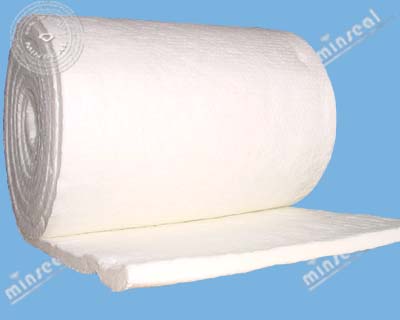Main Characteristics and Properties
- High temperature stable
- Lightweight, excellent handling strength
- Low thermal conductivity, low heat storage, thermal shock resistant
- Chemical and corrosion resistant, compatible with commonly used acid and alkali
- Excellent fire protection.
Chemical Composition: Al2O3: 47%, SiO2: 50%, total Al2O3 and SiO2 >97%, Fe2O3: < 1.0%
Fiber Diameter: 3 – 4.5 microns
Fiber Shrinkage (1800°F, 3h): < 3.5%
Working Temperature: 1,800 °F. for Continuous Use, 2300 °F Maximum
Specific Heat (@2000°F): 0.27 Btu/lb °F
Thermal Conductivity by Temperature (8 LB Density)
Unit: BTU⋅in/hr⋅ft2⋅ºF (w/mK)
Testing Standard: ASTM C 201
0.44 (0.06) @500°F (260°C)
0.87 (0.12) @1000°F (538°C)
1.45 (0.21) @1500°F (816°C)
1.83 (0.26) @1800°F (982°C)
2.09 (0.30) @2000°F (1093°C)
Product Applications
- Lining, insulation and repair for furnaces, kilns, ovens, boilers, steam reformers;
- Insulation for power plant, turbine, thermal reactor, generator, and nuclear applications;
- Expansion joint seal and insulation;
- Wrapping and insulation for high temperature pipe or metal casting;
- Fire protective insulation and lining
- Other high temperature seal, gasket, insulation, filtration or protection.
Product Sizes and Options
Density: 8 lbs./cu. ft. (64, 96, 128 kg/m3)
Thickness: 1/2″, 1″, 1-1/2″,2″ Width: 24″ and 48″
Also available with aluminum foil back
—————————————
Product Handling and Safety Information
Protective gloves, clothing and mask are recommended for product handling. Airborne fiber dust should always be kept down. Ceramic fiber may cause itching and irritation to skin and eyes by contact. If inhaled in sufficient amount of ceramic fiber, it may cause irritation to respiratory tract, scratchiness of the nose or throat, cough or chest discomfort. Ceramic fiber is classified in Group 2b (possible human carcinogen) by IARC. Based on animal study, it is a possible cancer hazard by prolonged heavy inhalation of this fiber. For detailed information, please refer to product SDS. (In animal studies, long-term laboratory exposure to doses hundreds of times higher than normal occupational exposures has produced fibrosis, lung cancer, and mesothelioma in rats or hamster., The fibers used in those studies were specially sized to maximize rodent respirability.)

